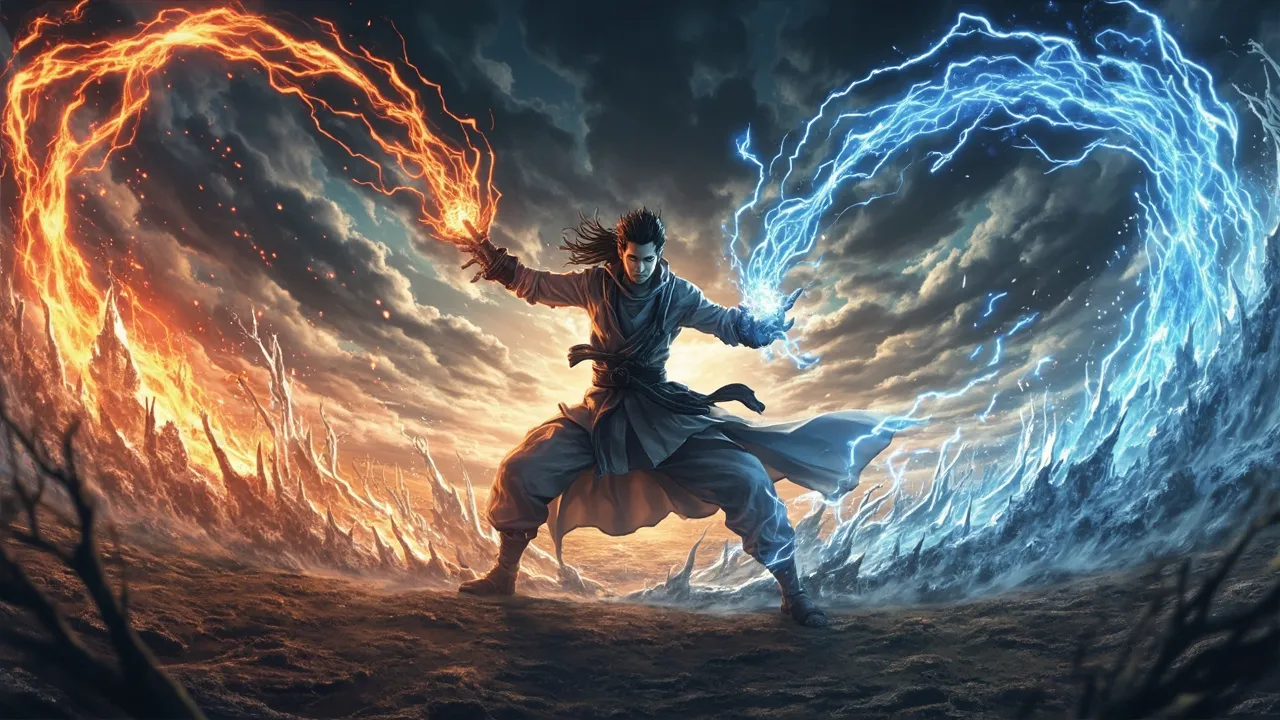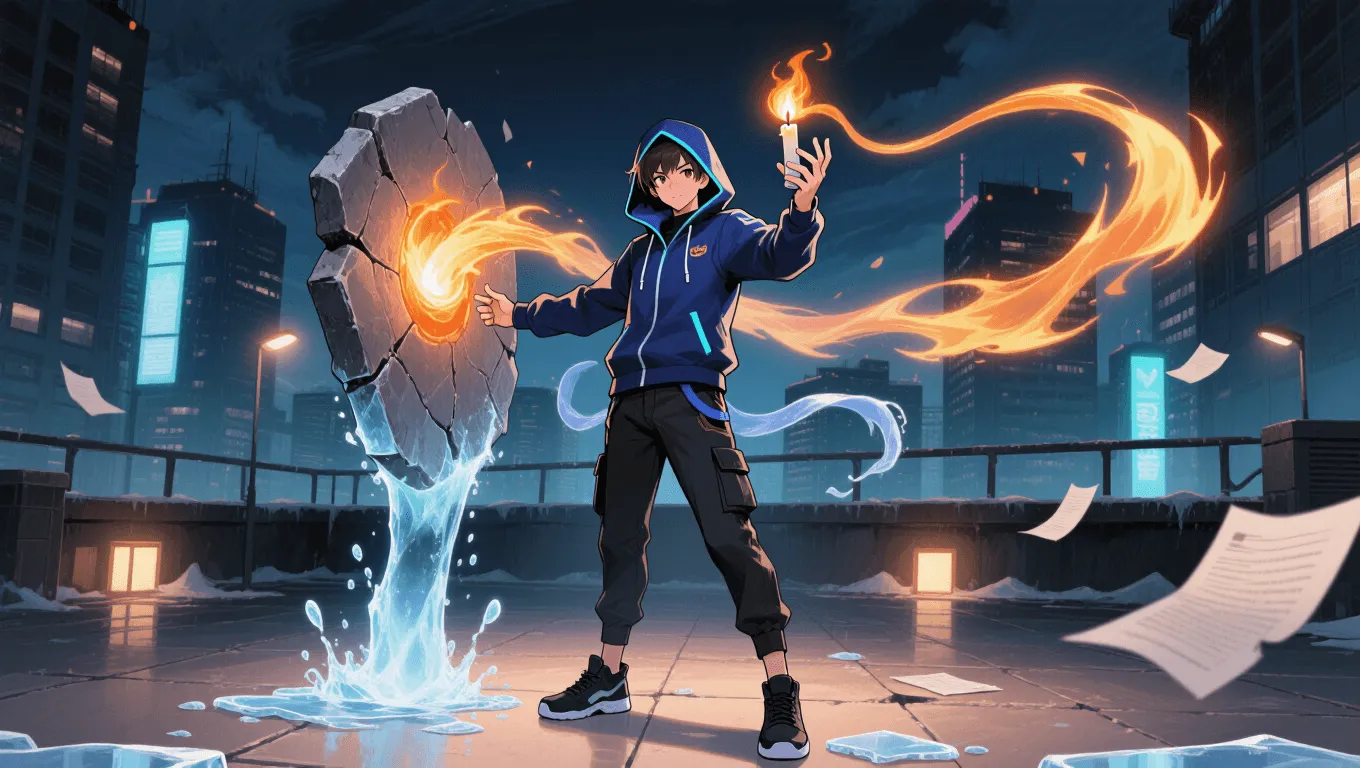Elemental Manipulation

Elemental Manipulation Video Demo 🎬
Table of Contents
- Elemental Manipulation Video Demo 🎬
- What Is Elemental Manipulation
- Core Abilities of Elemental Manipulation
- Application / Tactical Advantages in Combat
- Level: Level 1 🏙️, Level 2 🌇, Level 3 🌃
- Limitations of Using the Elemental Manipulation
- Weakness Against What Other Superpowers
- Synergistic Power Combos
- Known Users
What Is Elemental Manipulation
Elemental manipulation is the ability to generate, shape, and command the elements of nature. A user can direct fire, water, earth, and air—often expanding into lightning, ice, metal, sand, or weather manipulation. In fiction and games it is also known as elemental control, bending, or elemancy. Skilled practitioners treat the environment like a toolkit: building barriers from stone, redirecting lightning, freezing moisture into armor, or clearing smoke with pressure shifts. Whether the origin is mystical, genetic, or technological, elemental manipulation scales from small, precise tricks to battlefield-altering feats. For readers exploring more abilities, browse the full list on the Superpower Wiki, or try a surprise pick with the random superpower generator.
Core Abilities of Elemental Manipulation
Primary Element Families
-
Pyrokinesis (fire control): Ignite, project, and shape flames; regulate heat; create thermal blasts, flamethrower cones, or radiant shields.
-
Hydrokinesis (water control): Move and pressurize water; form cutting jets; craft hard-water constructs; manipulate steam and mist for cover.
-
Aerokinesis (air control): Direct wind currents, shear flows, and pressure; generate knockbacks, cushions for safe landings, or short aerial bursts.
-
Geokinesis/Terrakinesis (earth control): Raise ramparts, open trenches, compact rock; sense vibrations and underground cavities.
-
Electrokinesis (lightning control): Accumulate charge, arc bolts, interfere with electronics, and magnetize small metals via induced currents.
-
Cryokinesis (ice control): Lower ambient temperature, flash-freeze surfaces, create ice weapons and armor, or lay slick fields for crowd control.
Secondary Techniques and Hybrids
-
Weather shaping: Combine air, water, and temperature control to guide clouds, call rain, or dissipate fog banks on a local scale.
-
Sand/metal manipulation: Specialized geokinesis for granular media or refined ore; glass-making by vitrifying sand; shaping metal plates.
-
Transmutation within a domain: Drive phase changes—water to steam or ice, sand to glass, air to superheated plasma-like effects.
-
Constructs: Build spears, nets, domes, and bridges from the chosen element for offense, defense, or mobility.
-
Elemental sensing: Read humidity, barometric pressure, thermal gradients, or seismic tremors to anticipate threats.
Utility Beyond Combat
-
Environmental engineering: Rapid earthworks, firebreaks, drainage channels, de-icing, or smoke clearing for rescue operations.
-
Mobility: Surf waves, ride dust devils, skate on ice, launch via stone pillars, or glide on controlled updrafts.
-
Stealth and deception: Hide heat signatures, create mirages with mist and light refraction, or mask footsteps by damping vibrations.
Application / Tactical Advantages in Combat
Elemental manipulation excels at zone control and tempo management, allowing the user to reshape the conditions of a fight.
-
Initiation and spacing: Start with a gust or tremor to unbalance foes. Follow with a narrow fire lance or water jet for precision strikes.
-
Area denial: Ice sheets, mud traps, and dust storms slow advances; earthen berms funnel enemies into predictable lanes.
-
Crowd control: Fog walls break targeting; whirlwinds herd multiple combatants; electrified puddles punish clustered opponents.
-
Counter-siege: Stone bulwarks resist artillery; controlled down-drafts disperse gas or smoke; hard-water domes mitigate blast waves.
-
Anti-tech options: Moisture, sand, or static disrupt sensors; lightning shocks exposed circuits; ground spikes impair treads and anchors.
-
Support role: Create ramps and cover for allies, extinguish fires, stabilize damaged structures, and regulate local temperature for endurance.
A reliable playbook is sense → shape → strike → secure: scan with environmental cues, alter terrain or air, execute a focused attack, then seal the position with barriers or pressure locks. Smart users rotate elements to prevent counters and manage energy costs.
Level: Level 1 🏙️, Level 2 🌇, Level 3 🌃
Level 1 🏙️ — Initiate Elementalist

-
Scope: One primary element with limited generation and line-of-sight control.
-
Typical feats: Candle-to-torch ignition, knee-high water jets, gusts that stagger a person, waist-high stone shields, short-lived ice patches.
-
Sensing range: Room-scale awareness—detects drafts, warm spots, damp corners, or floor vibrations nearby.
-
Common mistakes: Overexerting to create mass from nothing; poor precision causing collateral; misreading conductive surfaces.
-
Training focus: Breath control for pressure changes, stance work for ground coupling, safety protocols (venting heat, drainage, breakaway paths).
Level 2 🌇 — Adaptive Controller

-
Scope: Two or three elements or deep specialization within one domain (e.g., water → ice/steam).
-
Typical feats: Car-stopping earth bulwarks, room-clearing gusts, hydrant-pressure water jets, medium-range lightning arcs, durable ice armor.
-
Tactical growth: Element chaining—soak terrain then electrify; whip up dust then glass it with heat; freeze armor joints then shatter.
-
Risks: Cognitive overload when juggling multiple media; unintended interactions (steam obscuring vision, wet ground aiding enemy electricity).
-
Training focus: Multithreaded attention, resource budgeting, and rules of engagement to minimize friendly-fire risk.
Level 3 🌃 — Master of the Elements

-
Scope: Large-scale, multi-element command with rapid transmutation and localized weather fronts.
-
Typical feats: City-block sand walls, precision lightning webs, vacuum pockets to mute sound, strong updrafts for sustained gliding, flood control.
-
Operational mindset: Treats the battlespace as a system; creates scarcity for adversaries (low traction, low visibility) and abundance for allies (cover, airflow, clean lines).
-
Risks: Ecosystem and infrastructure impact; legal and ethical constraints; fatigue causing abrupt collapse of constructs.
-
Training focus: Ethics, ecological modeling, teamwork choreography, and post-action stabilization (controlled melts, dewatering, slope shoring).
Limitations of Using the Elemental Manipulation
-
Environmental dependence: Some media must exist on-site or require high energy to create. Desert air limits hydrokinesis; vacuum nullifies aerokinesis and fire spread.
-
Energy and conservation: Phase changes and matter movement cost stamina or power. Heat taken to freeze an area must be sunk somewhere; stolen momentum has to be dissipated.
-
Line-of-sight and coupling: Walls, seals, and nonporous barriers block influence; liquids in closed systems resist manipulation; poorly coupled ground reduces tremor effects.
-
Precision vs. scale tradeoff: The larger the construct, the harder fine control becomes; micro-errors amplify under stress.
-
Collateral risk: Floods, sinkholes, and firestorms imperil civilians and allies; responsible users prioritize containment features.
-
Counter-tech: Insulation, Faraday cages, vibration-damping floors, hydrophobic coatings, and dehumidifiers mitigate many tricks.
-
Human limits: Overuse yields hypoxia, vertigo, tremors, or thermal shock; recovery protocols are essential.
Weakness Against What Other Superpowers
-
Power nullification: Dampeners, anti-magic zones, or suppression fields sever elemental channels, collapsing constructs.
-
Telepathy or sensory overload: Distraction breaks concentration; illusions that fake tremors or wind shifts cause misplays.
-
Force fields and hard-light barriers: Ignore terrain reshaping and absorb or deflect elemental projectiles.
-
Teleportation and ultrafast movement: Bypass walls, storms, and choke points, forcing predictive placement rather than reactive traps.
-
Gravity manipulation: Overrides air and earth tactics; pinned targets cannot leverage wind cushions or raised platforms.
-
Adaptive physiology: Heat- and cold-regulated opponents shrug off extremes; desiccation-resistant builds weaken hydrokinesis.
-
Vacuum generation: Removes the medium for aerokinesis and hampers combustion-based offense.
Synergistic Power Combos
-
Telekinesis + elemental manipulation: TK provides structural stability for massive constructs—levitated seawalls, hovering boulders, held storm eyes—while the elementalist sculpts and maintains flow.
-
Sound manipulation + aerokinesis: Use tailored pressure waves for nonlethal crowd control or stealthy sonic nulls by shaping micro-vacuums.
-
Plant control + hydro/geo: Instant irrigation and root-armored trenches; living barricades that self-repair under shielded rainfall.
-
Time dilation + cryokinesis: Freeze, then extend brittleness windows for clean captures with minimal damage.
-
Metal manipulation + terrakinesis: Extract ore, refine on-site, and plate allies with quick-curing armor; reshape battlefield infrastructure.
-
Light manipulation + mist/fog: Project holograms onto aerosol screens for misdirection, decoys, and area denial.
-
Healing/regeneration + thermal control: Push offensive temperatures while safeguarding allies with targeted cooling and heat-draw techniques.
Known Users
-
Storm (Marvel Comics): A signature weather controller who demonstrates top-tier air, lightning, and climate regulation. Read more about Storm.
-
Iceman (Marvel Comics): Master of cryokinesis capable of large-scale ice constructs and rapid self-reconstitution.
-
Terra (DC Comics): Geokinetic specialist using stone spires, seismic sensing, and terrain cages.
-
Mera (DC Comics): Hydrokinesis user known for hard-water constructs and deep-sea pressure mastery.
-
Zuko (Avatar franchise): Pyromancer showing precision flame redirection and growth through disciplined forms.
-
Korra (Avatar franchise): Multi-element bender illustrating quick element switching and system-level battlefield control.
Exploring more abilities? Visit the Superpower Wiki or roll a random pick with the random superpower generator.
